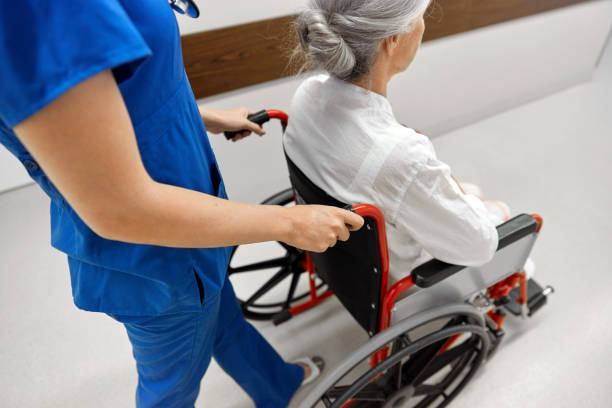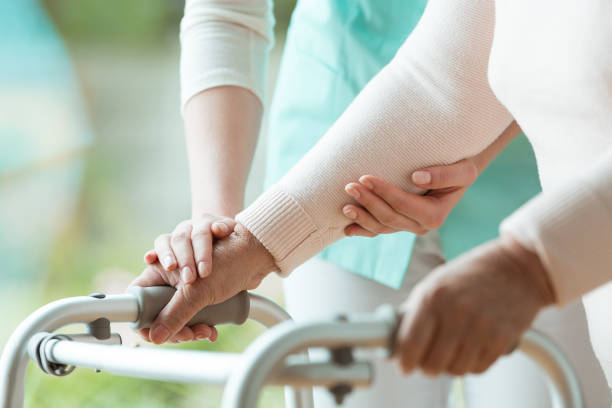Introduction

Living with Parkinson's disease can present various challenges, especially when maintaining mobility and independence. As the disease progresses, individuals may experience difficulties with balance, coordination, and walking, making it essential to explore different solutions that can enhance their mobility and quality of life. This comprehensive guide aims to shed light on the diverse range of mobility aids available for Parkinson's patients, focusing specifically on canes and walkers as effective tools for support and stability.
The upcoming blog post will cover the benefits and considerations of using canes and walkers.
The goal is to offer helpful information to help individuals with Parkinson's disease make informed decisions regarding their mobility needs. This applies to both those who have recently been diagnosed and those who have been living with the condition for some time. Parkinson's for a while, and comprehending the functions of these aids can help you stay active.
What is the best mobility aid for Parkinson's patients?
When choosing the best mobility aid for Parkinson's patients, there is no single answer. Different aids work better for different people depending on their physical condition and specific needs. Ultimately, the best type of mobility aid should be selected based on what will give the user the most freedom of movement while providing safe and secure support.
Canes are popular for Parkinson's patients due to their portability and lightweight. Canes can help improve balance while walking, reduce the amount of energy used when standing, and provide additional support during transfers from one seat to another. However, some individuals may find them uncomfortable or difficult to use.
Walker frames can also help Parkinson's patients stay on their feet longer. Walkers provide stability and balance while walking, enabling users to move more efficiently and with less fatigue. They also provide a supportive structure that allows the user to lean when standing or sitting down. However, some individuals may find them too bulky or cumbersome.
Wheelchairs are another option for Parkinson's patients with difficulty walking or standing for extended periods. Wheelchairs provide a comfortable and secure form of mobility that can help patients get around in less time than walking. They also offer improved independence, allowing users to travel longer distances without assistance. However, wheelchairs can be expensive and require modifications to meet the individual's physical needs.
Finally, motorized scooters are becoming increasingly popular among Parkinson's patients. These devices allow individuals to navigate their environment with greater ease and independence. Users can easily find a motorized scooter that fits their needs because they come in various sizes and styles. The scooters are suitable for indoor and outdoor use due to their lightweight and easy maneuverability.
Ultimately, the best mobility aids for Parkinson's patients depend on individual preferences and physical abilities. To select the best mobility aid for Parkinson's patients, it's important to consider individual preferences and physical abilities. Canes, walkers, wheelchairs, and motorized scooters have pros and cons, so evaluating each option carefully is important. Safety and mobility should both be taken into account when making a decision. You can select a device that meets your needs by prioritizing these factors.
Ways to Improve Mobility with Parkinson's

Regular Exercise:
For individuals with Parkinson's Disease, engaging in consistent exercise is crucial to enhance mobility. Exercise aids in preserving muscle strength, flexibility, and balance which Parkinson's Disease significantly impacts. It can also assist in weight maintenance and decrease tiredness when combined with a nutritious diet.
Some exercises that may help improve balance and coordination, reduce stiffness, and strengthen muscles include tai chi, walking, biking, swimming, and stretching.
-
Tai Chi: This gentle form of martial art can help enhance mobility by improving coordination and balance. It has also been found to help improve posture. Tai Chi is a gentle martial art that helps improve coordination, balance, posture, and mobility.
-
Biking: Cycling can help strengthen muscles while providing cardiovascular benefits. It can also be used as an aerobic exercise, helping to reduce fatigue.
-
Swimming: Swimming is a great way to improve coordination and balance while providing cardiovascular benefits. It can be done in a pool or outdoors, so finding an option that works for you is easy.
-
Stretching: Stretching can help increase flexibility and range of motion while reducing stiffness. It can be done in the morning and before bed to help improve overall mobility.
Physical Therapy:
Physical therapy is an important part of improving mobility for people with Parkinson's Disease. It can help improve balance, coordination, gait, and overall strength. Physical therapists can develop a personalized exercise program to meet patients' needs.
Physical therapists can also provide instructions on how to use certain assistive devices such as walkers, canes, and wheelchairs. They can also help teach safe transfer techniques to reduce the risk of falls.
In addition, physical therapists may suggest modifications to your home or work environment that can make daily activities easier and improve safety. This may include installing ramps or grab bars or advising on rearranging furniture.
Physical therapy can help people with Parkinson's Disease maintain independence and improve their quality of life. Working closely with your physical therapist to devise an exercise plan that works best for you is important.
Medication:
Medication can be an important part of improving mobility for people with Parkinson's Disease. Certain medications can help reduce the tremors, stiffness, and other symptoms associated with Parkinson's.
The most common types of medications used to treat Parkinson's are dopamine agonists, which work by increasing dopamine in the brain. They can help reduce tremors and improve coordination.
Other medications used to treat Parkinson's Disease include anticholinergics, which reduce stiffness. MAO-B inhibitors can also help control movement symptoms by blocking an enzyme that breaks down dopamine in the brain.
Talking to your doctor about the risks and benefits of your medications is important. Your doctor can also help you find the right combination of medications that work best for you.
While medication can effectively improve mobility, combining it with regular exercise and physical therapy is important for maximum benefit. These lifestyle modifications can help maintain mobility and independence for people with Parkinson's.
Mobility Aids:
Living with Parkinson's disease can be challenging, and mobility aids are a great way to help maintain your independence. Mobility aids such as canes, walkers, scooters, wheelchairs, and more can help you stay mobile and be free to go wherever you need or want to go. This guide will provide an overview of mobility aids and how they can benefit people with Parkinson's disease.
Should a person with Parkinson's use a walker?

Using a walker can be beneficial for people with Parkinson's disease. A walker can provide extra stability and balance when walking, which can help reduce falls and other injuries due to the symptoms associated with this condition. It also makes it easier to move around safely and independently in your home or outside.
When using a walker, you should always ensure it is the right size and height for your body. You can consult a physical therapist or other healthcare provider specializing in Parkinson's disease to help select the best model. It should be adjustable to set up properly for your specific needs.
FAQ's
What walking aid do people with Parkinson's use?
People with Parkinson's may use a variety of walking aids, such as canes, walkers, wheelchairs, and scooters. The type of aid that is best for you will depend on your individual needs and abilities. Your healthcare provider or physical therapist can help you find the right device.
What is a mobility walker for Parkinson's patients?
A mobility walker is designed to help people with Parkinson's stay mobile and independent. It provides extra stability and balance when walking, making moving around in your home or outside easier and safer. Many models are adjustable to be set up properly for each person's needs. Additionally, many models offer features such as brakes, adjustable arms, wheels, and folding options for storage.
What is the best treatment for Parkinson's in the world?
There is no one-size-fits-all treatment for Parkinson's disease since the condition affects different people differently. The best treatment plan will depend on each individual and their specific needs. Generally speaking, medication, physical therapy, exercise, and lifestyle changes can effectively manage symptoms and maintain mobility and independence for people with Parkinson's. Talking to your doctor about the risks and benefits of any treatments you are considering is important. Your doctor can help you find the right combination for you.
What is the latest treatment for Parkinson's disease?
The latest treatments for Parkinson's disease focus on improving the quality of life for those with the condition. These treatments often include medications, physical therapy, exercise, and lifestyle modifications. Medications can help reduce motor symptoms by blocking an enzyme that breaks down dopamine in the brain.
How can I improve my Parkinson's mobility?
Exercise and physical therapy can be beneficial for improving mobility in people with Parkinson's disease. Regular exercises such as walking, cycling, or swimming can help to improve muscle strength and coordination, while physical therapy can help you learn proper body mechanics for improved balance and movement.
Can you consciously stop a Parkinson's tremor?
It is possible to consciously stop a tremor associated with Parkinson's disease in some people. Strategies such as deep breathing, relaxation techniques, and visual cues can help reduce the frequency and intensity of tremors. However, it is important to consult your doctor before trying any technique, as certain strategies may not be effective or safe for everyone. Additionally, medications can also be used to help reduce tremors in some people with Parkinson's disease.
Conclusion
I hope this guide to mobility aids for Parkinson's disease patients has been helpful. A walking aid can help you stay mobile and independent while managing your symptoms. It is important to consult with your healthcare provider or physical therapist before selecting the best device for you, as certain models may be more effective than others depending on your individual needs and abilities. With the right support and care, you can lead an active life with Parkinson's disease.

